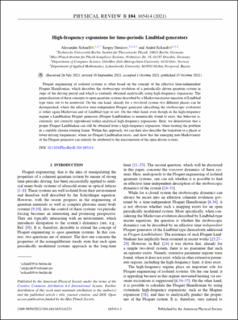| dc.contributor.author | Schnell, Alexander | |
| dc.contributor.author | Denysov, Sergiy | |
| dc.contributor.author | Eckardt, André | |
| dc.date.accessioned | 2022-03-01T14:38:41Z | |
| dc.date.available | 2022-03-01T14:38:41Z | |
| dc.date.created | 2021-11-10T19:24:15Z | |
| dc.date.issued | 2021-10-15 | |
| dc.identifier.citation | Physical review B (PRB). 2021, 104 (16), 1-22. | en_US |
| dc.identifier.issn | 2469-9950 | |
| dc.identifier.issn | 2469-9969 | |
| dc.identifier.uri | https://hdl.handle.net/11250/2982180 | |
| dc.description.abstract | Floquet engineering of isolated systems is often based on the concept of the effective time-independent Floquet Hamiltonian, which describes the stroboscopic evolution of a periodically driven quantum system in steps of the driving period and which is routinely obtained analytically using high-frequency expansions. The generalization of these concepts to open quantum systems described by a Markovian master equation of Lindblad type turns out to be nontrivial: On the one hand, already for a two-level system two different phases can be distinguished, where the effective time-independent Floquet generator (describing the stroboscopic evolution) is either again Markovian and of Lindblad type or not. On the other hand, even though in the high-frequency regime a Lindbladian Floquet generator (Floquet Lindbladian) is numerically found to exist, this behavior is, curiously, not correctly reproduced within analytical high-frequency expansions. Here, we demonstrate that a proper Floquet Lindbladian can still be obtained from a high-frequency expansion, when treating the problem in a suitably chosen rotating frame. Within this approach, we can then also describe the transition to a phase at lower driving frequencies, where no Floquet Lindbladian exists, and show that the emerging non-Markovianity of the Floquet generator can entirely be attributed to the micromotion of the open driven system. | en_US |
| dc.description.sponsorship | Open access publication funded by the Max Planck Society. | en_US |
| dc.language.iso | eng | en_US |
| dc.publisher | American Physical Society | en_US |
| dc.relation.ispartofseries | Physical review B (PRB);104, 165414 | |
| dc.rights | Navngivelse 4.0 Internasjonal | * |
| dc.rights.uri | http://creativecommons.org/licenses/by/4.0/deed.no | * |
| dc.subject | Nonequilibrium statistical mechanics | en_US |
| dc.subject | Quantum control | en_US |
| dc.subject | Quantum statistical mechanics | en_US |
| dc.subject | Quantum theories | en_US |
| dc.subject | Floquet systems | en_US |
| dc.subject | Master equations | en_US |
| dc.title | High-frequency expansions for time-periodic Lindblad generators | en_US |
| dc.type | Peer reviewed | en_US |
| dc.type | Journal article | en_US |
| dc.description.version | publishedVersion | en_US |
| dc.source.articlenumber | 165414 | en_US |
| cristin.ispublished | true | |
| cristin.fulltext | original | |
| cristin.qualitycode | 2 | |
| dc.identifier.doi | https://doi.org/10.1103/PhysRevB.104.165414 | |
| dc.identifier.cristin | 1953402 | |
| dc.source.journal | Physical review B (PRB) | en_US |
| dc.source.volume | 104 | en_US |
| dc.source.issue | 16 | en_US |
| dc.source.pagenumber | 1-22 | en_US |

